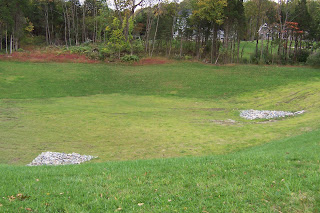Trouble-free Compost

We count among our most valuable gardening tools our paper shredder. That’s right, an office sized paper shredder. We originally bought it because we are conscientious recyclers and recognized how much mail and home office waste paper we were tossing into the garbage each week. But once I started shredding our daily newspaper, I realized what a valuable garden resource it is.
In wet weather, the newsprint often turns into pulp within a week, sometimes before Dan has time to mix it into the pile. We empty the bin over the top of a week’s accumulation of kitchen waste. The newspapers act like a blanket, causing the kitchen waste to decompose faster.
We have no lack of leaves and keep a separate mound of them adjacent to the compost pile, to add as needed. The leaves usually end up making their own wonderful black gold, with the earthy fragrance characteristic of the rest of the forest. The compost pile has no odor.
In winter, of course, it all works more slowly, but we’re in no hurry. Once the weather warms up, my army of worms sets to work. The very first year we used the paper shredder, I was momentarily frightened by a night crawler that was so large that I took it for a baby snake. Since then, the worms have come to populate the compost so densely that we have had to be much more careful when digging out the compost, in order not to injure them.
We’ve done nothing special to create our compost pile. We have no bins, we don’t rotate anything, we didn’t purchase any worms, and we don’t add any accelerators. Years ago, it started out as a place to dump the voluminous leaves that we raked up from the lawn. The kitchen waste is actually minimal, since there are just the two of us. The worms are the descendents of whatever primeval forbears have lived here since the beginning of time --- they just crawled up out of the ground and into the pile. Come spring, I pull lots of garlic mustard before it flowers, so that goes on the pile, too. Grass clippings stay on the lawn, so except for the weeds from the flower beds and uneaten apples, there isn’t much in the way of green matter.
Admittedly, we don’t have a need for great quantities of compost; our pile is about eight feet long by four feet wide and ranges in height from three to five feet. We use it to amend the soil as we are putting in each new plant, rather than attempting to improve an entire bed which, in our rocky soil, is physically impossible without using heavy equipment. And each year, I top-dress as many of the shrubs and individual plants as I can.

